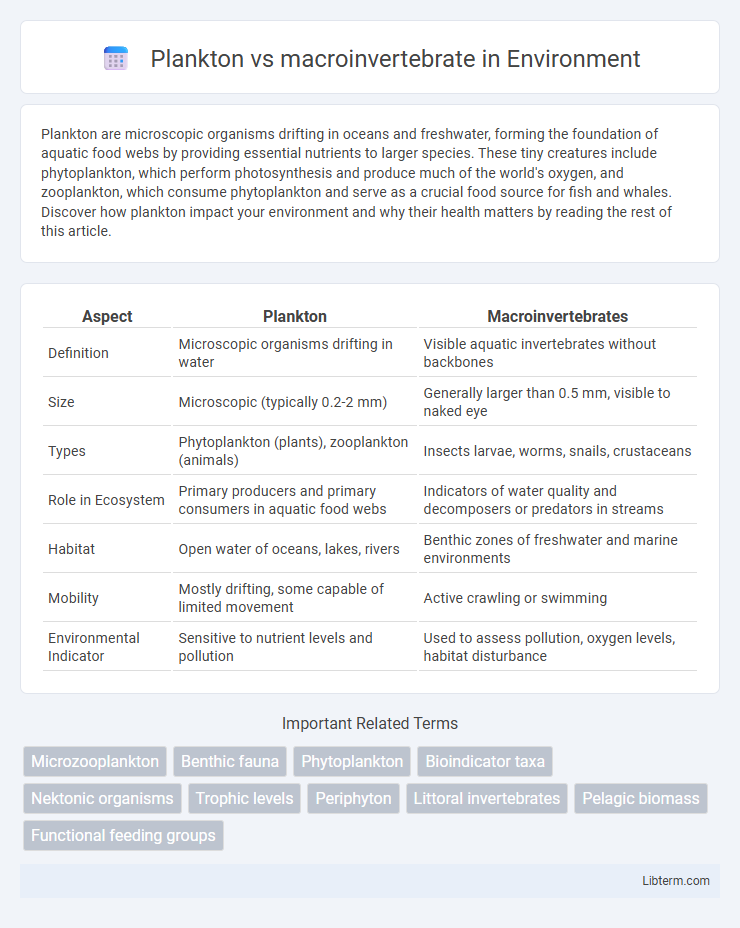Plankton are microscopic organisms drifting in oceans and freshwater, forming the foundation of aquatic food webs by providing essential nutrients to larger species. These tiny creatures include phytoplankton, which perform photosynthesis and produce much of the world's oxygen, and zooplankton, which consume phytoplankton and serve as a crucial food source for fish and whales. Discover how plankton impact your environment and why their health matters by reading the rest of this article.
Table of Comparison
| Aspect | Plankton | Macroinvertebrates |
|---|---|---|
| Definition | Microscopic organisms drifting in water | Visible aquatic invertebrates without backbones |
| Size | Microscopic (typically 0.2-2 mm) | Generally larger than 0.5 mm, visible to naked eye |
| Types | Phytoplankton (plants), zooplankton (animals) | Insects larvae, worms, snails, crustaceans |
| Role in Ecosystem | Primary producers and primary consumers in aquatic food webs | Indicators of water quality and decomposers or predators in streams |
| Habitat | Open water of oceans, lakes, rivers | Benthic zones of freshwater and marine environments |
| Mobility | Mostly drifting, some capable of limited movement | Active crawling or swimming |
| Environmental Indicator | Sensitive to nutrient levels and pollution | Used to assess pollution, oxygen levels, habitat disturbance |
Introduction to Plankton and Macroinvertebrates
Plankton consists of tiny, often microscopic organisms that drift in water columns, including phytoplankton (plant-like) and zooplankton (animal-like), playing a crucial role in aquatic food webs and oxygen production. Macroinvertebrates are larger, visible aquatic animals without backbones, such as insects, mollusks, and crustaceans, vital for assessing water quality and ecosystem health. Both groups serve essential ecological functions but differ significantly in size, habitat, and biological roles.
Defining Plankton: Types and Characteristics
Plankton comprises microscopic organisms drifting in aquatic environments, primarily divided into phytoplankton (photosynthetic algae) and zooplankton (tiny animals), characterized by their limited swimming ability and reliance on water currents for movement. These organisms form the foundation of aquatic food webs, playing a crucial role in oxygen production and nutrient cycling. In contrast to larger, benthic macroinvertebrates, plankton inhabit the water column and exhibit diverse adaptations for survival in pelagic zones.
Macroinvertebrates: Key Features and Diversity
Macroinvertebrates are vital indicators of aquatic ecosystem health, characterized by their lack of a backbone and inclusion of species such as insects, crustaceans, mollusks, and worms. Their diverse morphology and ecological roles range from filter feeders to predators, contributing significantly to nutrient cycling and energy flow in freshwater habitats. This group's sensitivity to pollution and habitat changes makes them essential for biomonitoring and assessing water quality.
Habitat Differences: Where Plankton and Macroinvertebrates Thrive
Plankton predominantly thrive in open water environments, including freshwater lakes, rivers, and oceans, where they drift with currents and sunlight penetration supports their photosynthetic species; in contrast, macroinvertebrates inhabit diverse habitats such as streambeds, river bottoms, and aquatic vegetation, often residing on or under substrates like rocks, logs, and sediments. Plankton populations are influenced by water temperature, nutrient availability, and depth, while macroinvertebrates depend on oxygen levels, substrate type, and water flow conditions for survival and reproduction. These habitat differences reflect adaptations that allow plankton to exploit pelagic zones and macroinvertebrates to colonize benthic niches, contributing to their distinct ecological roles in aquatic ecosystems.
Roles in Aquatic Food Webs
Plankton serve as primary producers and primary consumers in aquatic food webs, forming the foundational energy source for many aquatic organisms. Macroinvertebrates act as crucial secondary consumers and decomposers, breaking down organic matter and facilitating nutrient cycling. Both groups are essential for maintaining ecosystem stability and supporting higher trophic levels such as fish and amphibians.
Life Cycles and Reproduction
Plankton exhibit rapid life cycles, often completing multiple generations within days due to their microscopic size and fluctuating environmental conditions. Macroinvertebrates have longer, more complex life cycles that include distinct stages such as egg, larva, pupa, and adult, allowing for adaptation to diverse freshwater and terrestrial habitats. Reproductive strategies vary widely; plankton typically reproduce through asexual and sexual means to maximize population growth, while macroinvertebrates primarily rely on sexual reproduction with seasonal breeding patterns aligned to environmental cues.
Methods for Sampling and Studying
Sampling plankton involves using fine mesh nets, such as plankton nets with mesh sizes ranging from 20 to 200 micrometers, to collect microscopic organisms from water columns, followed by microscopic examination and flow cytometry for identification and quantification. Macroinvertebrate sampling typically employs kick nets, Surber samplers, or leaf packs to collect larger, benthic organisms from sediment or substrate in streams and rivers, with subsequent sorting, identification via taxonomic keys, and biomass estimation. Both methods require standardized protocols to ensure representative sampling and accurate assessment of ecological health and biodiversity.
Indicators of Water Quality
Plankton and macroinvertebrates serve as critical bioindicators for assessing water quality due to their sensitivity to environmental changes. Plankton populations, including phytoplankton and zooplankton, respond rapidly to nutrient levels and pollutants, reflecting immediate water chemistry alterations. Macroinvertebrates, such as insect larvae and mollusks, provide long-term bioassessment data by indicating cumulative impacts of pollution, sedimentation, and oxygen availability in aquatic ecosystems.
Human Impacts on Plankton vs Macroinvertebrate Populations
Human activities such as pollution, nutrient runoff, and habitat destruction significantly alter plankton and macroinvertebrate populations, often leading to reduced biodiversity and disrupted aquatic food webs. Chemical contaminants and eutrophication disproportionately affect plankton by causing harmful algal blooms, while sedimentation and physical habitat changes primarily impact benthic macroinvertebrate communities. Monitoring these populations provides critical feedback on ecosystem health and guides conservation strategies addressing anthropogenic pressures.
Conclusion: Ecological Significance and Future Research
Plankton and macroinvertebrates play critical roles in aquatic ecosystems as primary producers and indicators of environmental health, respectively. Understanding their interactions and population dynamics is essential for assessing ecosystem stability and biodiversity. Future research should focus on the impacts of climate change and pollution on these organisms to enhance conservation and management strategies.
Plankton Infographic

 libterm.com
libterm.com